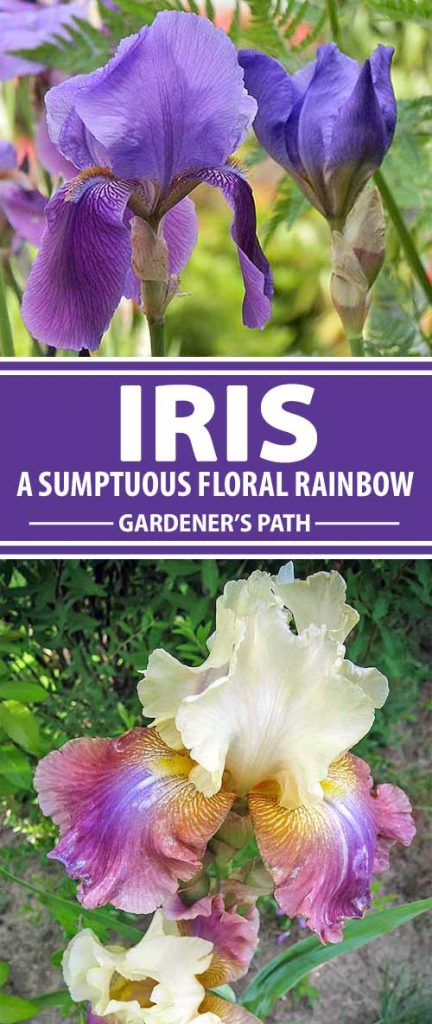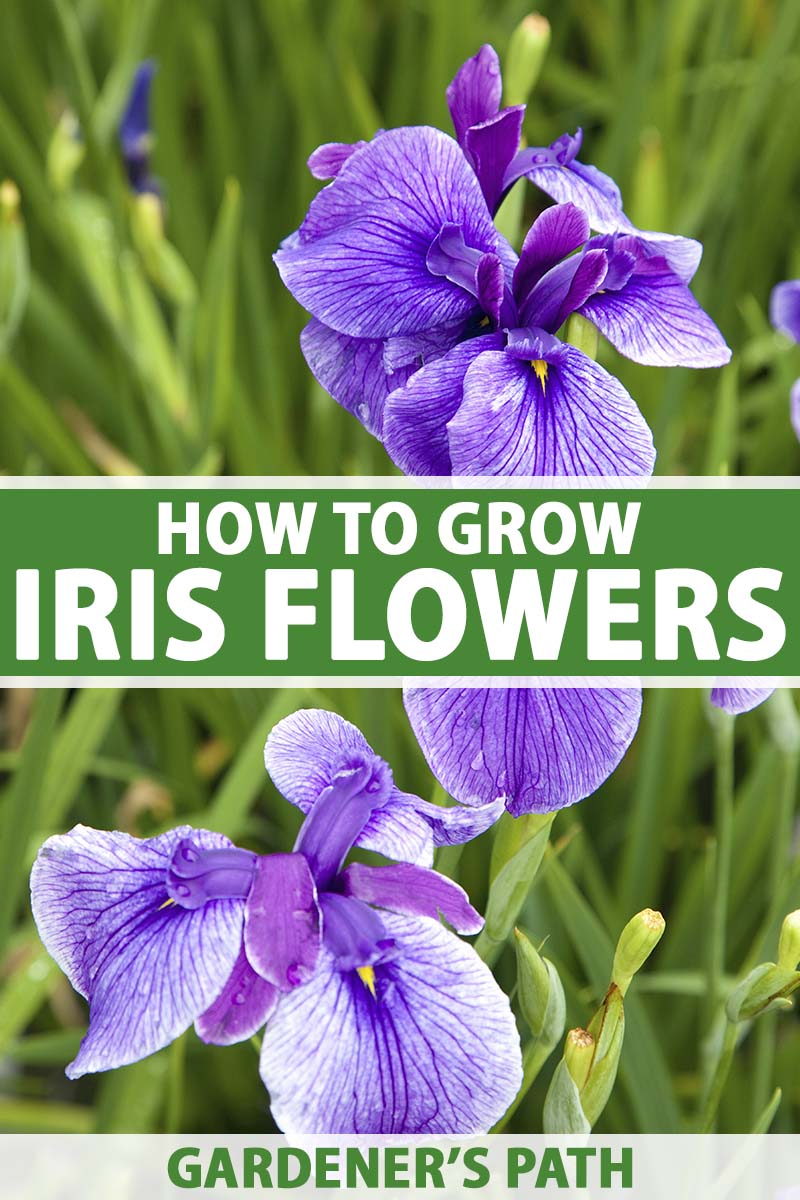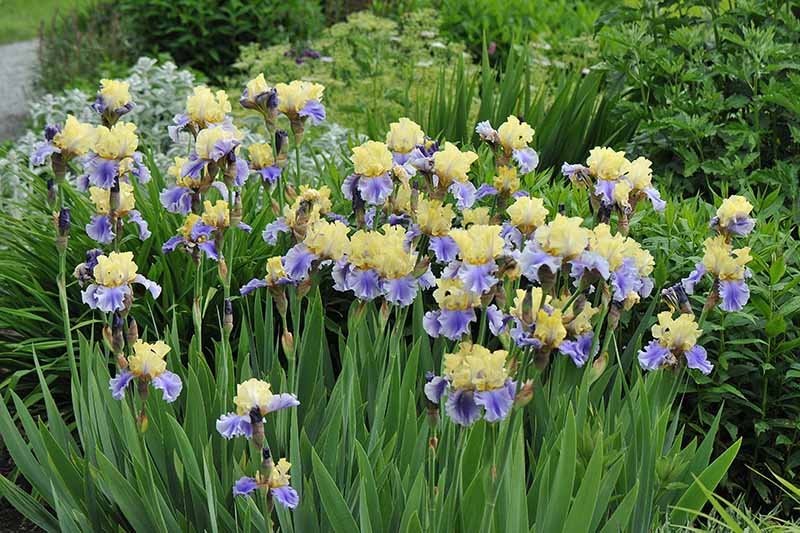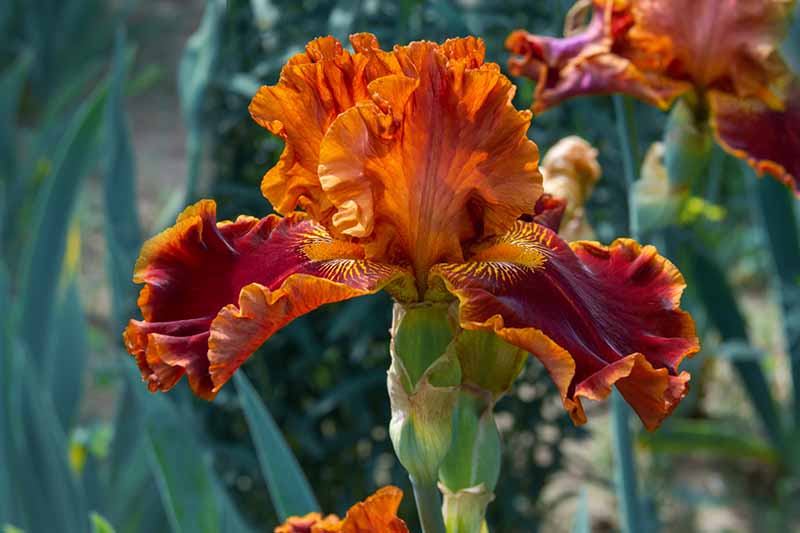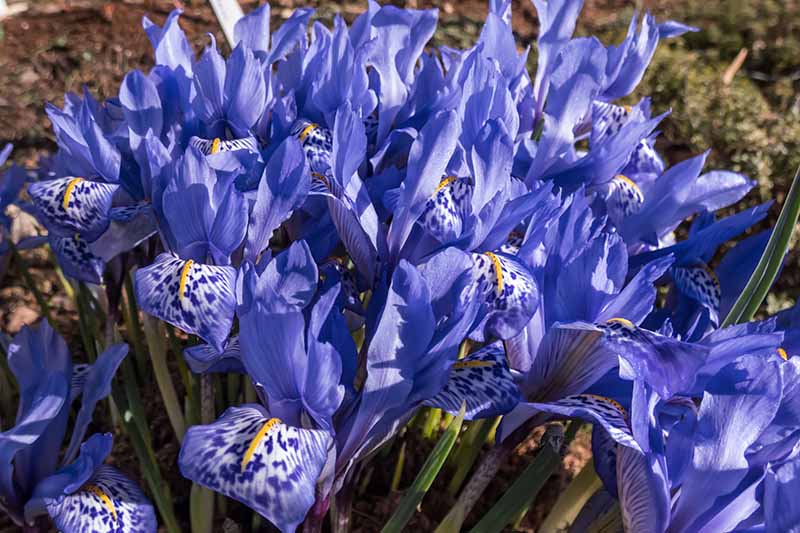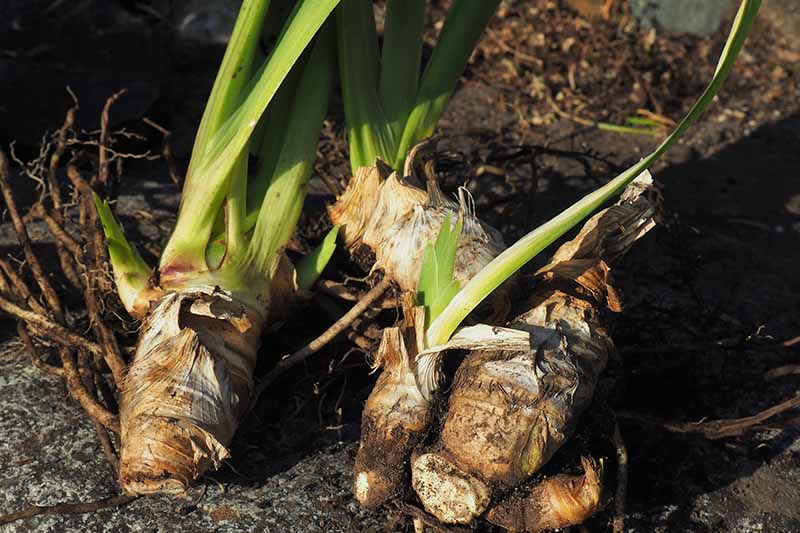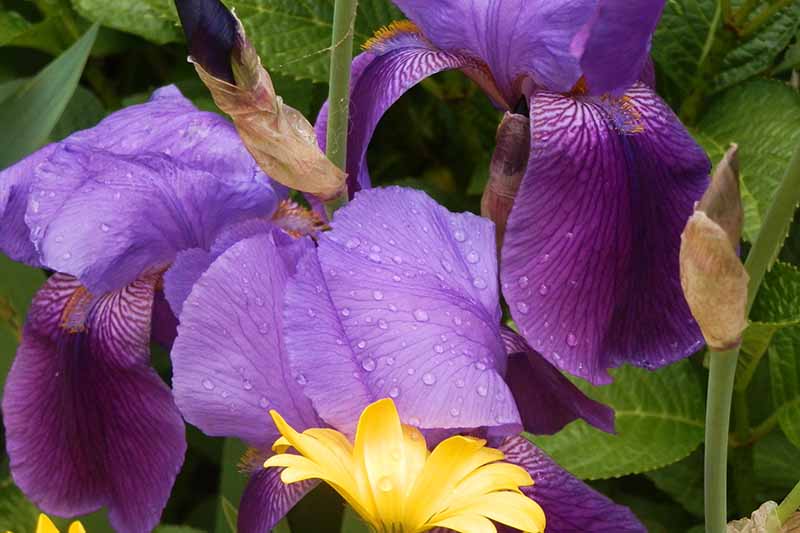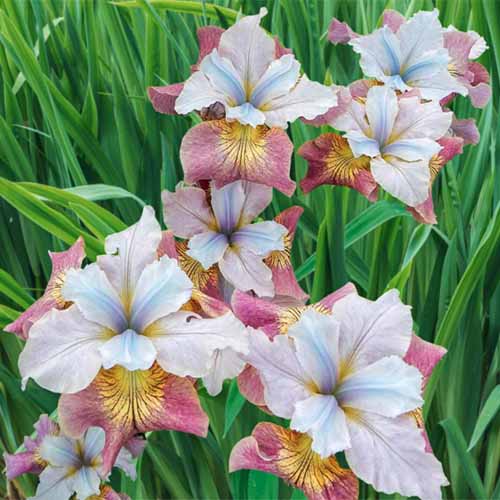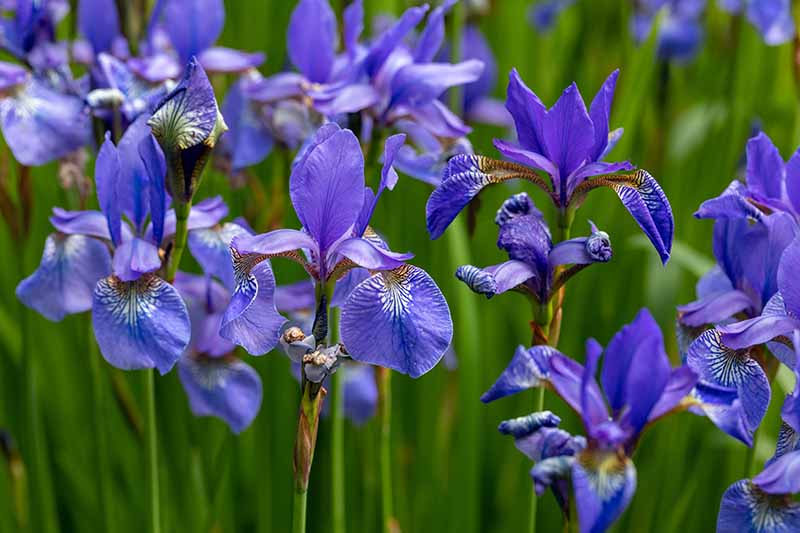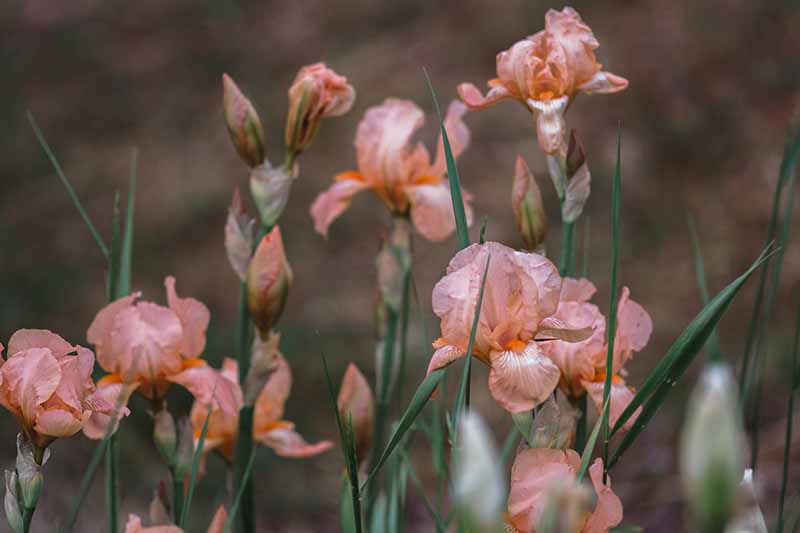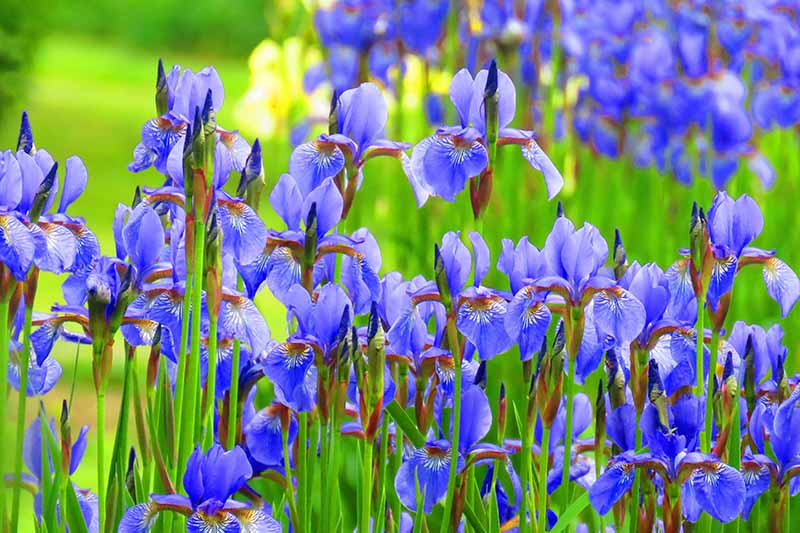The showy flowers sit atop tall, slender stalks, beautifully framed with fans of emerald green, spear-like leaves that add handsome vertical structure all season. Depending on the variety, they thrive in beds, borders, containers, naturalized areas, beside ponds and water features, or in butterfly, cutting, and cottage gardens. Plus, the gnarly rhizomes make a beautiful and functional choice for planting on steep or difficult slopes for erosion control. We link to vendors to help you find relevant products. If you buy from one of our links, we may earn a commission. The entrancing blooms are also sweetly fragrant, with a scent reminiscent of violets. The darker the flower’s color, the more intense the fragrance, and they make a long lasting addition to a vase of cut flowers. Rhizomes spread and multiply readily, forming attractive clumps and providing plenty of new plants. And they also attract important pollinators like bees, butterflies, and hummingbirds. Think you need to make a home for some in your garden? Join us now for all the details on how to grow iris for glorious color and fragrance! Here’s what I’ll cover:
What Are Irises?
A hardy herbaceous perennial, Iris is both the common and botanical name for this large genus in the Iridaceae family. These plants are beloved by gardeners for their colorful and fragrant flowers that bloom on tall, sturdy stems. Some close family members you’re likely familiar with include crocus, freesia, and gladiolus. Irises are classified as either bulbous or rhizomatous, and are native to temperate regions of Asia, Europe, and North America, with habitats as diverse as their colors. The rhizomatous types, with thick, fleshy rhizomes, are the most popular type for the home garden, and the focus of this guide. However, bulbous varieties, like the European and early-blooming I. reticulata species, add bold elegance as well, and also deserve a spot in the garden. To learn more about cultivation of iris bulbs, check our guide on how to grow bulbous iris. In the wild, plants can be found in a variety of settings from arid and semi-desert regions to bogs, meadows, and along riverbanks. All irises display elaborate flower heads comprised of three large outer petals called “falls” that flare out or drop downwards, and three inner, upright petals known as “standards.” There are some 300 species within the genus plus hundreds of cultivars. For growing purposes, irises are loosely grouped into early, mid, and late season varieties. And they also come in three different sizes, with dwarf varieties growing only six to 12 inches tall, intermediates that grow to heights of 17 to 27 inches, and tall ones measuring 24 to 48 inches. Rhizomatous varieties are reliable in USDA Hardiness Zones 3-10 in areas with dry summers, and Zones 3-8 in regions with warm, moist summers. You can learn more about the different types of irises in our guide.
Cultivation and History
The Iris genus is named for the goddess who carried messages from the gods of Olympus to earth along a rainbow. And where she set foot, beautiful flowers of every color bloomed. Among the earliest known artworks dedicated to the love of iris is a mural at the palace of Minos on Crete, that dates to circa 2400 BC. In ancient Egypt, King Thutmose III grew Syrian irises and had their image engraved in stone at the Temple of Amon. Later kings were also enamored by these flowers, and since the 6th century AD, the stylized iris in the form of the fleur-de-lis has been used as a symbol for the French monarchy. Although North America has several native species, early settlers planted I. germanica stock brought from Europe, with the first cultivation recorded in the late 1600s at Bacon’s Castle, Virginia. These plants are also cultivated for orris root powder – the dried, powdered root of I. germanica, I. pallida, or I. florentia. Used primarily as a base note in perfumes, orris root has a delicate floral fragrance and is also used as a fixative in perfumes and in potpourri blends. It’s also used in the kitchen and is one of the 30-plus spices often included in ras el hanout, a spice blend used in Morocco and other North African countries. And when it is distilled, orris retains its floral notes, and is used to add depth and color to many brands of gin, contributing a sweet, earthy flavor.
Propagation
For flowers the following year, the best way to propagate iris is by rhizome division. However, propagating species plants from seed is also an option, although the germination rate can be as low as 50 percent and it can take two to three years for flowers to appear. Seeds from hybrid varieties will not grow true to the parent plant.
From Seed
Seeds can be direct sown outdoors in autumn at a depth of half an inch, provided they’ll receive the cold temperatures needed for vernalization: 34 to 41°F for at least 60 days. If you wish to start seeds indoors, add three or four seeds to small, four-inch pots, or space seeds an inch apart in a tray of moist peat moss, perlite, or vermiculite, cover with a quarter to half an inch of medium and place inside a lightly sealed plastic bag. Place in the refrigerator or other cold area where the temperature is between 34 and 41°F for at least 60 days. For germination, it’s important that seeds have the right combination of cold and moisture during this vernalization period. At the end of the cold period, place the pots or trays (still in the bag) in a warm location that receives bright, indirect light. The ideal temperature for germination is 70 to 75°F. Once seeds have sprouted, remove the bag from the tray or pots. Water lightly when the top of the soil dries out. When plants have three sets of true leaves, acclimatize them for their new life outdoors for a week or so. Place in a lightly shady spot for two or three days, then morning sun with afternoon shade for two or three days, then full sun after that. When all danger of frost has passed, plant out into the garden as described below.
Root Division
Over time, rhizomes can become crowded which can inhibit flowering, and clumps should be divided every three to five years. To rejuvenate clumps and create new plants, divide roots approximately six to eight weeks after flowering, or mid to late summer. Use a garden fork to loosen the soil a few inches outside the root clumps, digging six to eight inches deep. Carefully pry and lift the roots from the soil, ensuring you don’t spike the rhizomes. Pull rhizomes apart by hand or use a clean sharp knife to cut them. Select only healthy pieces and discard any that are soft, rotting, or show evidence of root borers (see the Managing Pests and Disease section below for info on root borers). Dust the cut pieces with a powdered fungicide such as garden sulfur. Use clean garden pruners to reduce leaf size by half – this prevents new plantings from being dislodged by wind. Replant new stock as outlined below. Find more tips on dividing irises here.
How to Grow
Rhizomatous irises require a full sun location in humus-enriched, well-draining soil with an ideal pH of 6.8. They also enjoy having a bed of their own to allow the creeping rhizomes to grow and spread. Rhizomes can be planted any time after flowering, from midsummer to early autumn. Before planting, soil should be loosened with a garden fork to a depth of 12 to 16 inches, with compost or well-rotted manure mixed into the top six inches. To improve drainage, mix in a shovelful or two of landscape sand or pea gravel, if needed. To plant, dig a hole a few inches longer than the rhizomes and about four inches deep, and mix in some bone meal. Pile some loose soil into a ridge four inches high down the middle of the planting hole. Place the rhizome on top of the ridge, laying the roots down on both sides. Gently backfill the hole, covering the roots but leaving the top of the rhizome exposed. Firm the soil in place and water deeply. When working with soil and mulching, it’s important to leave the rhizome tops exposed to the drying sun and air. If they are covered with soil or mulch, the excess moisture can lead rhizomes to sour and rot. Plant rhizomes singly or in groups of three or five, spacing them about three to five inches apart for dwarf and miniature varieties and four to six inches apart for tall ones. The leaf fans should be outermost with groups spaced 12 to 24 inches apart – less distance for dwarf varieties and more for tall bearded types. For container growth, ensure pots have adequate drainage holes. Fill containers with a light, well-draining potting soil and plant as outlined above, keeping the rhizome tops exposed to the sun. Water lightly to settle in place, and afterwards, water when the top two inches of soil are dry. In winter, move containers to a frost free location or add a layer of leaf or straw mulch for cold protection.
Growing Tips
Give plants a sunny spot in well-draining soil.Provide ample spacing when planting tall bearded varieties as they need good air circulation.Use a light touch with mulch and ensure rhizome tops are exposed to the sun.Cut back foliage in fall to deter overwintering pests.
Pruning and Maintenance
Apply a low nitrogen or balanced fertilizer (6-10-10 or 10-10-10) in early spring and once again after flowering. Deadhead seed pods from species plants to prevent beds from becoming overcrowded with seedlings. After flowering, cut back the flower stalks but leave the leaf fans in place. Trim any brown tips if needed, but preserve the leaves, as they’re needed to produce energy for next year’s growth. By fall, leaves brown and die back. At this time you can cut them back to six to eight inches to tidy beds and prevent pests and disease from overwintering. The remaining foliage will die back over winter and can be cleaned up in early spring. To prevent overcrowding, lift and divide clumps every three to five years. To keep weeds down and roots moist, mulch beds lightly to a depth of two inches – but remember to keep the crowns clear. If you live in a cold region, cover beds with a mulch of leaves or straw for winter. Remove in early spring once new growth appears.
Water Iris aka Northern Blue Flag
One of our North American natives, I. versicolor features lightly fragrant flowers of azure blue to royal purple with yellow throats and handsome veining. Bloom time lasts from late spring to midsummer. Here are a few of today’s popular choices:
Albovariegata
Variegated sweet iris, I. pallida ‘Albovariegata’ features dreamy flowers of lavender blue with a contrasting yellow beard, a heady floral fragrance, and striking, variegated foliage in cream and sage green. ‘Albovariegata’ Sublime in beds, cottage and cutting gardens, and naturalized areas or open woodlands, this species is also one of the sources of orris root. Hardy in Zones 4-9, plants grow 24 to 36 inches in height. Plants in #1 containers are available at Nature Hills Nursery.
Beverly Sills
Is that angels singing? You’ll think so when the magnificent I. germanica ‘Beverly Sills’ puts on its stunning performance in the late spring to early summer garden with large, ruffled flowers of flamingo pink highlighted by a tangerine beard. ‘Beverly Sills’ A multiple award winner, this tall bearded cultivar adds elegance to beds and foundations as well as cottage, courtyard, and cutting gardens. Plants reach mature heights of 30 to 36 inches and are hardy in Zones 3-9. Bare root rhizomes are available at Burpee.
Harvest of Memories
Memorable for their long flowering season and fragrant, sunny flowers of lemon yellow, I. germanica ‘Harvest of Memories’ is a reblooming bearded cultivar that flowers first in late spring then again in late summer to early fall. ‘Harvest of Memories’ A bright addition to beds and foundations or cottage, courtyard, and cutting gardens. Plants reach a height of 24 to 36 inches and are hardy in Zones 3-10. Bags of rhizomes are available at Eden Brothers.
Sugar Rush
In delicate pastel shades, I. siberica ‘Sugar Rush’ is a lightly fragrant, beautiful bicolored cultivar with blue streaked, off-white standards and magenta pink falls with a yellow signal patch. ‘Sugar Rush’ Growing to a height of 26 to 32 inches, this Siberian cultivar flowers in late spring to early summer and prefers a site with moist soil. Plants make a striking addition to beds, borders, containers, pond perimeters, and cutting or wild gardens. Hardy in Zones 3-9. Bare root plants are available at Home Depot. I. versicolor loves moist soil and makes a tall, regal statement massed besides ponds, streams, and water features. Plants grow 30 to 36 inches and are hardy in Zones 3-9.
Managing Pests and Disease
Deer resistant and drought tolerant, irises usually enjoy good health. However, there are a few pests as well as bacterial and fungal infections to watch for. Be sure to check out our list of the top 33 best iris cultivars to help you find the best fit for your landscaping. There are thousands of varieties out there and we’ve narrowed it down to a selection of those with different color patterns, sizes, flowering times, and availability to help make your selection(s) a little easier.
Pests
Aphids are small green or gray insects that suck sap from the leaves and also spread disease from plant to plant. Get rid of aphids easily with a strong blast of water from a garden hose to both sides of the leaves. Borers are the larvae of the Macronoctua onusta moth and target the rhizomes of the tall bearded varieties of I. germanica. Check rhizomes on a regular basis for small holes about the size of a pencil lead or leaves that appear water-soaked. Any plants found to be infested should be removed and discarded. Caterpillars can chew holes in the foliage but are usually easy to control with handpicking. Snails and slugs are also known to munch on leaves and flowers, creating irregular holes. Handpick and dispose of these pests, and remove any nearby hiding places such as boards, bricks, and garden debris. Weevils such as Mononychus vulpeculus are a pest that like to breed in the seed pods of I. versicolor, and purple Siberians, I. siberica. If pods show multiple small holes, remove them and discard. Diatomaceous Earth Food grade diatomaceous earth is available at Arbico Organics.
Disease
Soft rot is caused by the bacteria Erwinia carotovora and can be a problem for bearded iris, I. germanica. Most likely to occur during warm, wet springs, symptoms include soft, smelly rhizomes, decay at the base of leaves, and fan wilting. When soft rot strikes, scoop out infected areas with a spoon and let the sun dry the remaining tissue. Fungal crown rot, caused by Sclerotium rolfsii, is a spreading, soft gray mat that covers rhizomes and the base of leaf fans causing decay, and most often appears in warm, moist conditions. Bonide Sulfur Plant Fungicide Bonide Sulfur Plant Fungicide is available at Arbico Organics. To prevent crown rot, maintain sanitary garden beds, use clean, sterile tools when dividing rhizomes, and promptly remove any infected material. If crown rot is a regular problem, disinfect rhizomes before planting by dipping them in a solution of bleach and water – 10 percent bleach to 90 percent water. Leaf spot is a fungal infection caused by Cladosporium iridis, and most common on I. germanica. It appears as water-soaked leaf spots that merge and darken to brown and may have sooty-looking spores in wet weather. Remove and dispose of any plant parts infected by leaf spot. Rust, caused by Puccinia iridis fungi, shows up as small light green to yellow spots with a rusty brown bump that progresses to black as leaves yellow and wither from the tip down. Remove and discard any infected leaves in the trash to halt the spread of rust.
Best Uses
Irises offer incredible diversity with a huge array of colors, forms, and sizes that make them welcome in almost any area of the garden. Be sure to plant some beside pathways and patios, or anywhere you can enjoy their sweet perfume and watch the butterflies and hummingbirds they attract. Intermediate and taller varieties make a spectacular addition massed in the center or background of mixed perennial beds and foundation plantings, and in cottage, courtyard, and cutting gardens. Dwarf and intermediate sizes grow well in containers and patio pots, and all sizes – dwarf, intermediate, and tall – make delightful borders. Crested varieties such as I. crestata do well in light shade gardens because they can get by with less full sun than most others. Easy to cultivate, these robust plants multiply readily and provide charming flowers that increase yearly. Remember to give them plenty of sunshine, provide excellent drainage, and keep the tops of their rhizomes exposed to the sun and air for masses of flowers. How do you folks like to use iris in the garden? Drop us a line and tell us in the comments section below! And for more ideas on early spring to midsummer bloomers, add these articles to your reading list next:
Azalea Bloom Times and Flowering GroupsHow to Plant and Grow Anemone FlowersHow to Plant and Grow the Classic Perennial Peony
